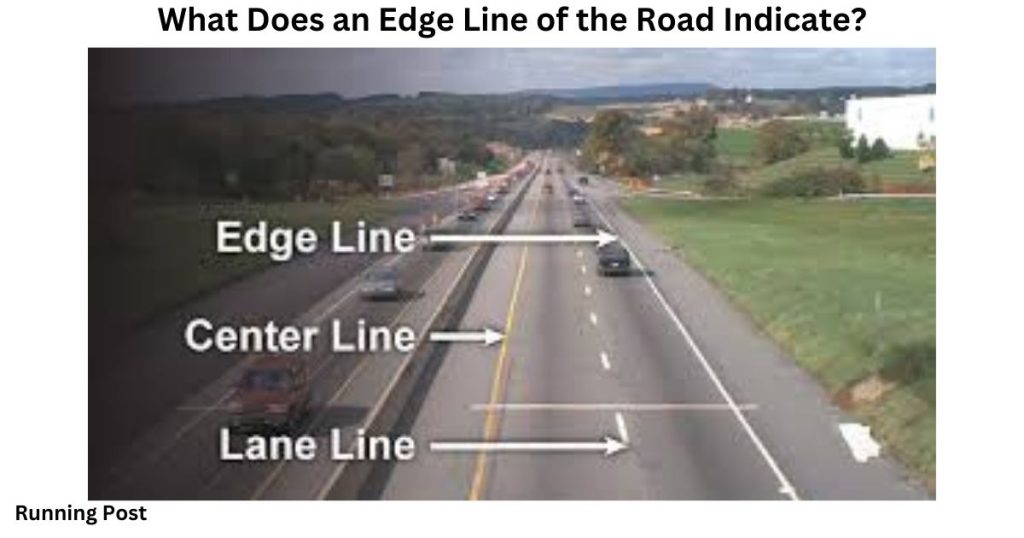| A: The edge of the carriageway | B: No overtaking | C: It indicates the center of the road | D: It marks a pedestrian crossing area |
Understand The What Does the White Line Along the Side of the Road Indicate?
White lines along the side of the road, known as edge lines, serve a vital role in road safety by indicating the boundary of the carriageway. These lines guide drivers, especially in poor visibility conditions like fog, heavy rain, or nighttime, helping them stay within safe driving limits. They also prevent vehicles from accidentally drifting off the road, which can lead to accidents or collisions. Edge lines are particularly useful on narrow or winding roads, where the risk of veering off the road is higher. They are essential for creating a safer driving environment and maintaining orderly traffic flow.
- Indicates the boundary of the carriageway: Keeps vehicles within the safe driving area.
- Helps in low visibility conditions: Assists drivers during fog, rain, or at night.
- Prevents accidents: Reduces the risk of drifting off the road.
- Useful on narrow or winding roads: Guides drivers safely through challenging road sections.
Understanding Road Markings: An Overview
Road markings are essential tools for communicating road rules and ensuring safety. They provide critical guidance to drivers, cyclists, and pedestrians, helping them understand the layout of the road and navigate safely. Different types of markings, such as longitudinal lines, transverse lines, and various symbols, each serve specific functions. Longitudinal lines manage lane discipline and traffic flow, while transverse lines, like stop lines and crosswalks, enhance safety at intersections. Maintaining these markings is crucial; faded or unclear markings can confuse drivers, leading to potential accidents.
- Communicates road rules: Informs road users of regulations and lane usage.
- Guides different road users: Provides clear instructions for drivers, cyclists, and pedestrians.
- Types include longitudinal and transverse lines: Each type has specific functions like lane separation or pedestrian crossing.
- Regular maintenance is crucial: Ensures visibility and prevents confusion.
Importance of Road Markings for Safety and Navigation
Road markings are crucial for both safety and navigation on the roads. They guide drivers in maintaining their lane positions, ensuring smooth traffic flow and preventing collisions. Markings like solid and dashed lines indicate whether passing is allowed, contributing to safer overtaking maneuvers. They are particularly important in urban areas, where traffic density and complexity are high, helping drivers navigate intersections and roundabouts safely. Reflective markings enhance visibility during night or adverse weather conditions, further reducing the risk of accidents.
- Ensures lane discipline: Helps maintain proper lane positions and prevents collisions.
- Indicates passing rules: Guides safe overtaking maneuvers.
- Important in urban areas: Manages high traffic density and complex road layouts.
- Reflective markings for visibility: Improves safety in low-light and adverse conditions.
Types of Road Markings and Their Meanings
Road markings come in various forms, each with a specific meaning and function. Longitudinal lines like edge lines, center lines, and lane lines define traffic lanes and manage traffic flow. Transverse lines, such as stop lines and pedestrian crossings, ensure safety at intersections. Additionally, arrows and symbols on the road surface provide direction and warn of upcoming changes, like merging lanes or roundabouts. Understanding these markings is essential for safe driving and effective navigation.
- Longitudinal lines: Define lanes and manage traffic flow.
- Transverse lines: Indicate stopping points and pedestrian crossings.
- Arrows and symbols: Provide directions and warnings about road changes.
- Enhances driver understanding: Crucial for safe driving and effective navigation.
What Are the White Lines on the Side of the Road For?
White lines on the side of the road, or edge lines, primarily serve to indicate the boundaries of the driving lane. They help prevent vehicles from straying onto the shoulder or off the road entirely. These lines are especially beneficial in rural or less illuminated areas, providing a visual guide that keeps drivers within safe limits. They are crucial in areas where the road may narrow or where there are obstacles near the road’s edge, such as guardrails or ditches.
- Indicates lane boundaries: Prevents vehicles from straying off the road.
- Beneficial in low-visibility areas: Guides drivers safely in poorly lit conditions.
- Important in rural areas: Assists navigation on narrow or winding roads.
- Prevents accidents with obstacles: Helps avoid guardrails, ditches, and other hazards.
The Purpose of Edge Lines
Edge lines serve multiple purposes beyond merely marking the side of the road. They act as a safety measure by alerting drivers when they are veering too close to the road’s edge. In addition, these lines provide a psychological guide, encouraging drivers to maintain a consistent distance from the side, which is particularly important in high-speed areas. Edge lines also help separate vehicles from cyclists or pedestrians, providing a safer environment for all road users.
- Acts as a safety measure: Alerts drivers when veering too close to the edge.
- Psychological guide: Encourages maintaining a consistent distance from the side.
- Separates different road users: Provides a clear boundary between vehicles and cyclists or pedestrians.
- Enhances safety in high-speed areas: Reduces the risk of vehicles drifting off at higher speeds.
How Edge Lines Guide Drivers
Edge lines guide drivers by providing a continuous, visible boundary that helps them stay oriented on the road. In conditions of poor visibility, such as heavy rain, fog, or nighttime driving, these lines become even more critical, offering a reference point to prevent vehicles from veering off. They also help drivers gauge road width and anticipate curves or bends in the road, contributing to safer driving practices and reducing the risk of accidents.
- Provides a visible boundary: Helps drivers stay oriented on the road.
- Critical in poor visibility: Offers a reference point in adverse conditions.
- Helps gauge road width: Assists in anticipating curves or bends.
- Reduces accident risk: Contributes to safer driving practices.
What Does an Edge Line of the Road Indicate?

The edge line of the road indicates the boundary between the carriageway and the shoulder or verge. It plays a crucial role in defining the safe limits for vehicles, ensuring that drivers do not accidentally veer off the paved road surface. These lines are particularly important in areas with narrow roads or minimal lighting, where the risk of accidents is higher. Edge lines also serve to enhance road safety by keeping vehicles within their lanes, especially in hazardous conditions like fog, rain, or snow.
- Indicates the boundary between road and shoulder: Defines safe driving limits.
- Crucial in narrow or poorly lit areas: Reduces the risk of veering off the road.
- Enhances road safety: Keeps vehicles within their lanes in hazardous conditions.
- Reduces accident risk: Important for maintaining safe driving practices.
Delineating the Edge of the Carriageway
Delineating the edge of the carriageway with a white line is vital for maintaining road order and safety. This line serves as a guide that helps drivers identify the safe limits of the road, particularly in unfamiliar or challenging driving conditions. By providing a clear boundary, it helps prevent drivers from accidentally drifting off the road, which can lead to accidents or damage to the vehicle. This marking is especially useful in high-traffic or high-speed areas where precision in lane keeping is essential.
- Provides a clear boundary: Helps drivers stay within safe road limits.
- Prevents accidental drifting: Reduces accidents and vehicle damage.
- Useful in high-traffic areas: Ensures precise lane-keeping.
- Essential in high-speed zones: Maintains road order and safety.
Enhancing Road Safety with Edge Lines
Edge lines enhance road safety by providing a constant visual cue that helps drivers remain aware of their position on the road. These lines are particularly beneficial on roads with narrow shoulders or where there are steep drop-offs or ditches nearby. They help prevent accidents by keeping vehicles within the safe bounds of the road. Additionally, edge lines can be reflective, which improves their visibility at night or during adverse weather conditions, further enhancing road safety.
- Provides a visual cue: Keeps drivers aware of their position on the road.
- Beneficial on narrow roads: Prevents vehicles from veering off near hazards.
- Reflective for visibility: Improves safety at night or in poor weather.
- Reduces accidents: Enhances overall road safety.
You Also Like It:
Why are vehicles fitted with rear fog lights?
What’s the nearest you may park to a junction?
How should a load be carried on your roof rack?
What Is the Meaning of the White Straight Line in the Middle of the Road?
The white straight line in the middle of the road, also known as the center line, separates traffic moving in opposite directions. This line is crucial for maintaining lane discipline and preventing head-on collisions by clearly indicating the division of lanes. In some areas, this line may be solid, indicating that crossing is not allowed, while in other areas, it may be dashed, indicating that overtaking or passing is permissible when safe. The center line’s role is to ensure that traffic flows smoothly and safely by keeping vehicles within their designated lanes.
- Separates opposite traffic flows: Maintains lane discipline.
- Prevents head-on collisions: Clearly indicates lane divisions.
- Solid vs. dashed lines: Dictates passing rules and safety.
- Ensures smooth traffic flow: Keeps vehicles in their designated lanes.
Differentiating Center Lines from Edge Lines
Center lines and edge lines serve different purposes on the road. While the edge lines indicate the boundaries of the driving lane, the center lines separate opposing traffic flows. The center line is critical in preventing head-on collisions by maintaining clear lane discipline. In contrast, edge lines guide drivers within their lanes and prevent vehicles from drifting off the road. Understanding the difference between these two types of lines is essential for safe driving and effective navigation.
- Different purposes: Center lines separate traffic, edge lines mark boundaries.
- Prevents head-on collisions: Center lines maintain lane discipline.
- Guides within lanes: Edge lines prevent vehicles from drifting.
- Essential for safe driving: Helps in understanding road layout.
Traffic Flow and Lane Discipline
Traffic flow and lane discipline are essential aspects of road safety, heavily influenced by road markings like center lines and edge lines. Center lines ensure that vehicles stay in their designated lanes, preventing collisions and promoting smooth traffic movement. Lane discipline is critical for avoiding accidents and maintaining an orderly flow, especially in congested or high-speed areas. Road markings play a vital role in reinforcing these rules, helping drivers navigate safely and effectively.
- Ensures vehicles stay in lanes: Prevents collisions and promotes smooth traffic.
- Promotes lane discipline: Avoids accidents and maintains order.
- Important in congested areas: Helps manage high traffic volumes.
- Reinforces traffic rules: Aids in safe and effective navigation.
What Does a Single Line on the Road Mean?
A single line on the road, whether solid or dashed, conveys important information about driving behavior. A solid single line typically indicates that passing or lane changes are prohibited due to safety reasons, such as sharp turns or limited visibility. In contrast, a dashed single line allows for passing when it is safe to do so. Understanding these distinctions is crucial for maintaining safety and avoiding traffic violations. Drivers must pay close attention to these lines to ensure they adhere to the rules and drive safely.
- Solid vs. dashed lines: Solid lines prohibit passing; dashed lines allow it.
- Indicates driving behavior: Guides safe lane changes and overtaking.
- Prevents traffic violations: Ensures compliance with road rules.
- Maintains road safety: Crucial for safe driving practices.
Solid vs. Broken White Lines
Solid white lines indicate that changing lanes or overtaking is not permitted, often used in areas where safety is a concern, such as curves, intersections, or pedestrian zones. Broken white lines, however, suggest that lane changes are allowed when safe. These markings help manage traffic flow and maintain road safety by dictating when it is appropriate for vehicles to change lanes or overtake. Understanding the difference between these two types of lines is essential for all road users to avoid accidents and ensure smooth traffic flow.
- Solid lines prohibit lane changes: Used in high-risk areas.
- Broken lines allow lane changes: Permits overtaking when safe.
- Manages traffic flow: Dictates safe driving practices.
- Essential for road users: Prevents accidents and ensures smooth movement.
Passing Rules and Traffic Regulations
Passing rules and traffic regulations are often dictated by the road markings. A solid white line means no passing is allowed, ensuring that drivers do not attempt dangerous overtaking maneuvers in unsafe areas. A broken white line permits passing when it is safe, allowing for smoother traffic flow. Adhering to these rules is crucial for road safety, as improper passing can lead to severe accidents. Drivers should always be aware of these markings and follow the regulations to avoid penalties and ensure safety.
- Solid line: No passing allowed: Prevents dangerous maneuvers.
- Broken line: Passing allowed when safe: Promotes smooth traffic flow.
- Adhering to rules is crucial: Ensures road safety and avoids penalties.
- Prevents severe accidents: Reduces the risk of collisions.
Conclusion: What does the white line along the side of the road indicate?
Road markings, including white lines along the side of the road, play an essential role in maintaining road safety and ensuring efficient traffic flow. These markings provide guidance and warnings to all road users, helping them navigate safely and adhere to traffic regulations. From edge lines that indicate the boundary of the carriageway to center lines that separate traffic flows, each type of marking contributes to a safer driving environment. Understanding and respecting these markings is crucial for preventing accidents and maintaining order on the roads.
- Maintains road safety: Provides guidance and warnings.
- Ensures efficient traffic flow: Helps manage road user behavior.
- Contributes to a safer environment: Prevents accidents and collisions.
- Understanding markings is crucial: Essential for all road users.
Summary of Key Points on Road Markings
In summary, road markings are a vital part of road safety and traffic management. White lines along the side of the road, or edge lines, guide drivers and indicate safe driving limits. Center lines separate opposing traffic flows, while solid and dashed lines dictate passing rules. Understanding these markings helps ensure that drivers stay within their lanes, avoid accidents, and comply with traffic regulations. Regular maintenance of these markings is also essential to keep them visible and effective.
- Edge lines guide drivers: Indicate safe driving limits.
- Center lines separate traffic: Prevent head-on collisions.
- Solid and dashed lines dictate passing rules: Maintain road safety.
- Regular maintenance is essential: Keeps markings visible and effective.
Tips for Staying Aware of Road Markings While Driving
Staying aware of road markings is crucial for safe driving. Drivers should always pay attention to the lines on the road and understand their meanings. Regularly checking for road markings, especially in unfamiliar areas or in adverse weather conditions, can help prevent accidents. Using headlights during low visibility and maintaining a safe speed can also improve the ability to see and follow road markings. Staying focused and avoiding distractions ensures that drivers can respond quickly to any changes in the road layout.
- Pay attention to road markings: Understand their meanings.
- Check for markings regularly: Especially in unfamiliar or poor conditions.
- Use headlights and maintain speed: Improves visibility and adherence.
- Avoid distractions: Stay focused for quick responses.
You Also Like It:
Why are place names painted on the road surface?
Where will you see these red and white markers?
Who’s responsible for paying the vehicle excise duty (road tax)?
Releated Posts
MAB Instructor Certification: Your Gateway to Professional Crisis Management Leadership
In today’s fast-evolving professional environments—especially in healthcare, mental health, education, and corrections—conflict and aggression can arise without warning.…
Freewayget.com: Your Ultimate Platform for Deals, Discounts, and Digital Products
Introduction to Freewayget.com In today’s fast-paced digital world, finding reliable platforms that offer authentic discounts, deals, and digital…
Affordable & Fast Embroidery Digitizing Services in Your Area
Embroidery digitizing services provide corporations, designers, and people with brilliant embroidery-equipped designs by means of changing art work…
Introduction to hdhub4u nit
In this article, we will delve into the details of hdhub4u nit, exploring its features, benefits, and why…

















